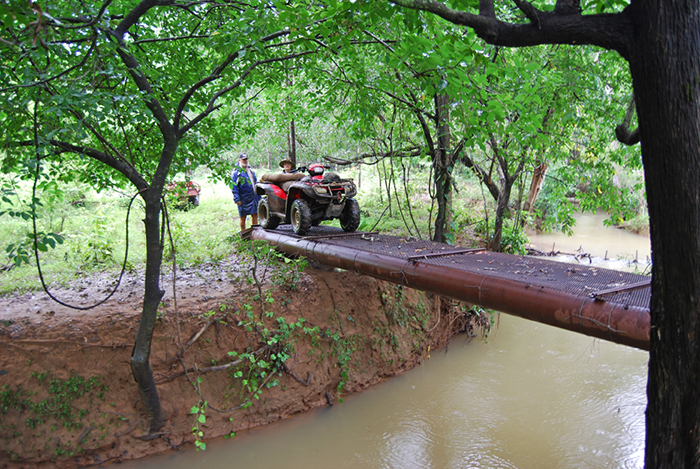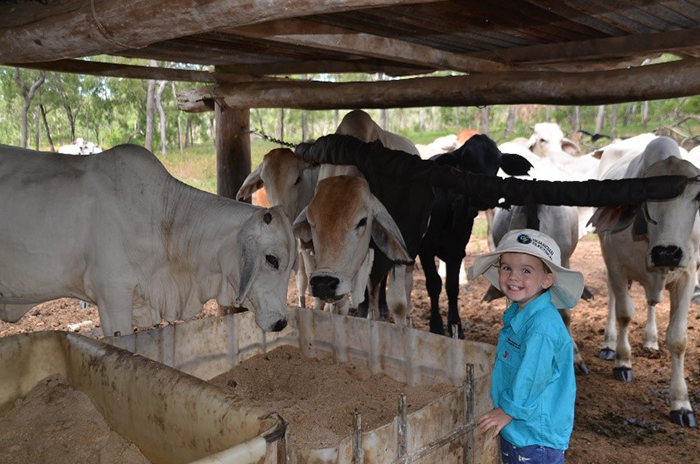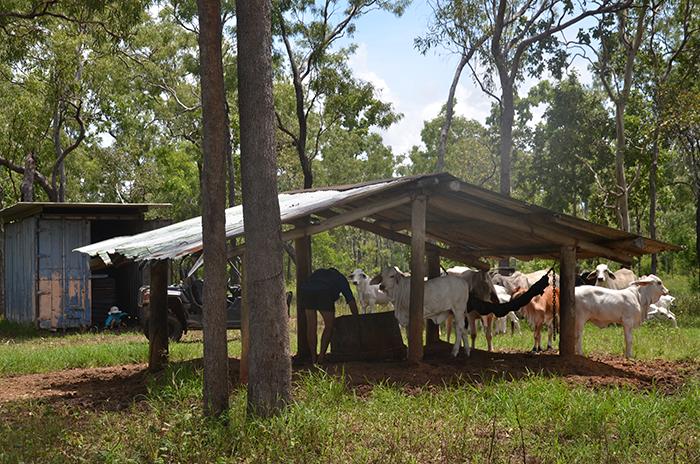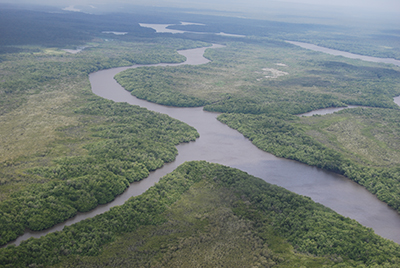‘Watson River Station’, Cape York, Queensland
‘Watson River Station’, located south of Weipa on Cape York Peninsula, has an annual rainfall of 1,500mm. Like many areas across north Queensland, the soils are acutely deficient in P and property access during the wet season is a challenge.
On a mix of sandy and clay soils on forest country, Watson River runs 1,300–1,500 Brahman breeders. Weaning rates, including joiner heifers, average 57% and breeder losses range from 2–3%. Weaner steers are transported to a second family property on the Atherton Tablelands to be grown out to around 320kg prior to sale to local bullock producers.
It is about a decade since the first P case study was completed on Watson River Station. At that time, Cameron and Doreen Quartermaine had developed the 89,000ha property to the point where half was fenced, and the balance was bush country. During the intervening period, intergenerational transfer has occurred with Luke and Ally Quartermaine now managing Watson River. Their goal is to continue developing the bush country and equip a third generation with the necessary skills to take over the Watson River beef operation.
Feeding P
Aside from property development and herd improvement, the most significant management strategy applied over several decades by the Quartermaine family has been the feeding of P supplements to all cattle for the entire wet season.
“On Watson River we do our P lick order for our cattle before we do our food order for the station,” Cameron said.
The Watson River wet season P recipe (Table CS2.1) includes a mix of monodicalcium phosphate (MDCP: 21% P), GranAm™, lime, sulphur, salt and trace minerals, as well as 2% molasses to settle dust during supplement production in the factory. A similar recipe has been used for decades on the Watson River.
Feeding in lick sheds eliminates rain spoilage and maintains lick palatability. Over the wet season, mature breeders require at least 10g P/head/day with less for weaners or replacement heifers. The Quartermaines aim for breeders to consume around 80g/head/day of lick which, at 12% P (as fed), delivers the required 10g of P/breeder/day. However, it is not unusual to see daily lick intakes fluctuate during the wet season. GranAm™, a source of non-protein nitrogen, is used to help fill the protein gap as pasture quality declines later in the wet season.
Although used successfully on Watson River, GranAm™ is sour and can sometimes reduce supplement intake. Many northern producers are reluctant to use GranAm™ in their wet season supplements as target wet season P intakes are often difficult to achieve. The inclusion of lime (7%) in exposed wet season P loose licks (as in bulk bags) helps form a surface crust and weatherproof the recipe. In the case of Watson River, all supplement is fed and protected in substantial lick sheds so the inclusion of lime in their recipe may be revisited next year. High humidity during the 2019 to 2020 wet season caused some crusting of covered supplement and may have restricted intakes.
Table CS2.1: The wet season lick recipe is 12% P as fed and is readily consumed by all classes of cattle on Watson River
|
Ingredients |
Inclusion rate |
|
GranAm™ |
10% |
|
Monodicalcium phosphate (MDCP) |
57% |
|
Lime |
7% |
|
Sulphur |
3% |
|
Salt |
20% |
|
Molasses |
2% |
|
Trace minerals |
1% |
P supplementation on Watson River greatly improves pasture intake over the wet season and is critical in maximising herd productivity, from liveweight gain through to pregnancy and lactation rates. The herd and economic benefits of wet season P are further highlighted by the Watson River herd analysis conducted by the Queensland Department of Agriculture and Fisheries team in March 2020. When compared to not feeding P supplements, P supplementation on Watson River increased weaning rates from 46% to 57% and reduced breeder mortalities from 6% to 3%. Feeding P also increased female and steer sale weights by 7% and 9% respectively. Even though the number of weaners produced by the wet season P supplemented herd only increased by 29 (776 to 805), the overall lift in herd efficiency due to the wet season P feeding program improved overall property profitability by about 60% (Table CS2.2).
Table CS2.2: The herd performance, turn-off age, turn-off value and gross margins at Watson River with, and without, wet season P supplementation
|
No wet season P supplementation |
With wet season P supplementation |
|
|
Total adult equivalents (AE) |
2,100 |
2,100 |
|
Total cattle carried |
2,467 |
2,341 |
|
Total breeders mated and kept |
1,558 |
1,347 |
|
Total calves weaned |
776 |
805 |
|
Weaners/total cows mated |
46% |
57% |
|
Overall breeders deaths |
6% |
3% |
|
Female sales/total sales |
39% |
46% |
|
Total cows and heifers sold |
244 |
336 |
|
Total steers sold |
388 |
401 |
|
Average female price |
$687 |
$784 |
|
Average steer price |
$382 |
$514 |
|
Direct costs excluding bulls |
$50,005 |
$70,917 |
|
Bull replacement |
$32,245 |
$26,737 |
|
GM per adult equivalent |
$111 |
$177 |
Wet season access
The difficulty of delivering wet season lick during the northern monsoon season should not be underestimated. However, due to the considerable production gains from P feeding, the Quartermaine family have infrastructure and management systems in place so P can be fed to all cattle while there is green grass.

Cameron and Luke have installed four large shipping containers at points around the property for bulk dry mix storage. These containers can hold up to 14 tonnes of dry mix and are filled before the wet season in November each year. A quad bike and side-by-side bridges allow access over flooded creeks to deliver supplement to 31 covered troughs throughout nine paddocks (see photo above). The lick troughs on Watson River are well sheltered from monsoonal rains by wide corrugated iron lick sheds. Each trough holds roughly 240kg of supplement (12 x 20kg bags), and lick shed materials range from steel to strong and termite-resistant bush timber such as Cooktown ironwood.

All lick sheds include back rubbers carefully positioned to control buffalo fly on breeders, weaners and calves (see photo above). The buffalo fly insecticide and oil is stored in bulk in the shipping containers along with the P supplement. The side-by-side buggy and quad bikes are the main means of travel during the wet season to check cattle, fill supplement troughs and change back rubbers on a weekly basis.
Herd and land management
Luke and Ally have used the opportunity provided by recent cattle prices to sell down a portion of the herd and effectively halve the stocking rate on the fenced portion of Watson River. This is aimed at improving land condition through wet season spelling and reducing end of dry season mortalities.

The heavier culling of breeders and replacement heifers has produced a breeding herd with an even temperament and better overall reproductive performance. The feeding of wet season P supplements and the focus on temperament allows for an efficient first-round muster even with extensive surface water across all paddocks. The Watson River first-round muster is a couple of months earlier than on comparable properties that do not have the same herd supplementation and management strategies in place. This enables more timely weaning and helps maintain breeder body condition.
Watson River currently has approximately 325ha of improved grasses and legumes on cleared country as well as a hay paddock. The fertilised hay paddock produces sufficient hay to meet the Watson River requirements, as well as a surplus supply for sale or use at local events like the annual show and rodeo.
Future development plans include the:
- subdivision of existing breeder paddocks for pasture spelling and improved herd management
- installation of additional water and cattle handling facilities on the remaining bush country to expand the breeder herd over time.
Breeders and heifers are vaccinated for botulism, weaners are vaccinated with 7-in-1 and all cattle are treated to control ticks. Luke has kept a few of the better Watson River male calves as herd bulls.
As the next generation of managers on Watson River Station, Luke and Ally share a passion for, and a commitment to, the northern beef industry. Their clear focus on feeding wet season P, herd management, moderate stocking rates and wet season spelling are the key strategies for a successful beef operation on Watson River for years to come.




